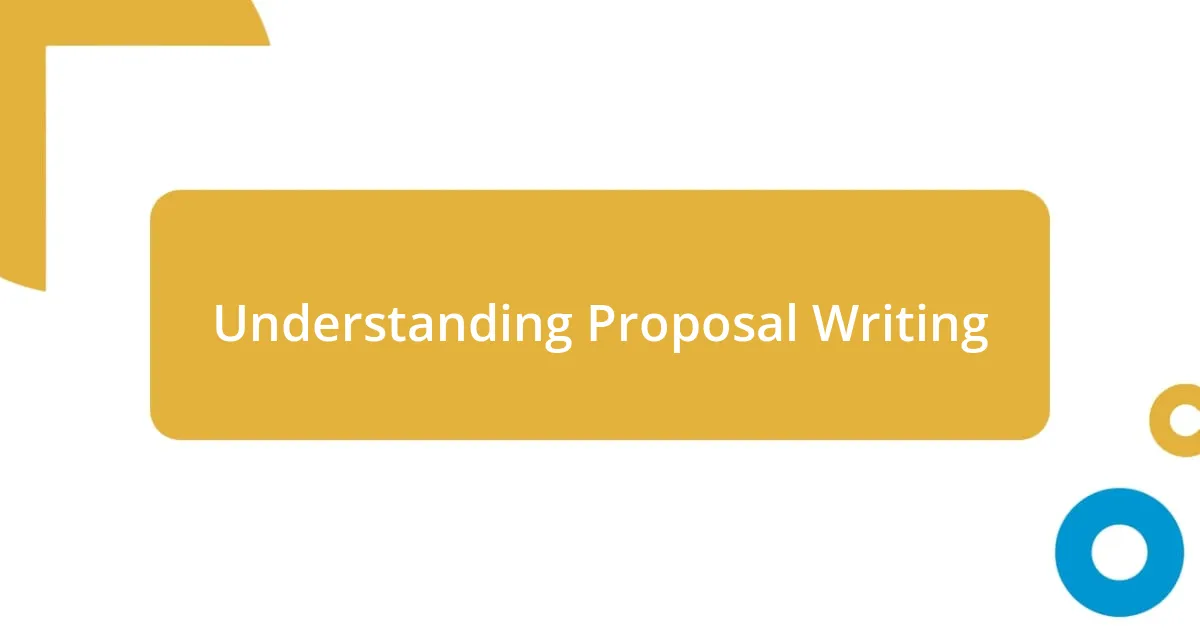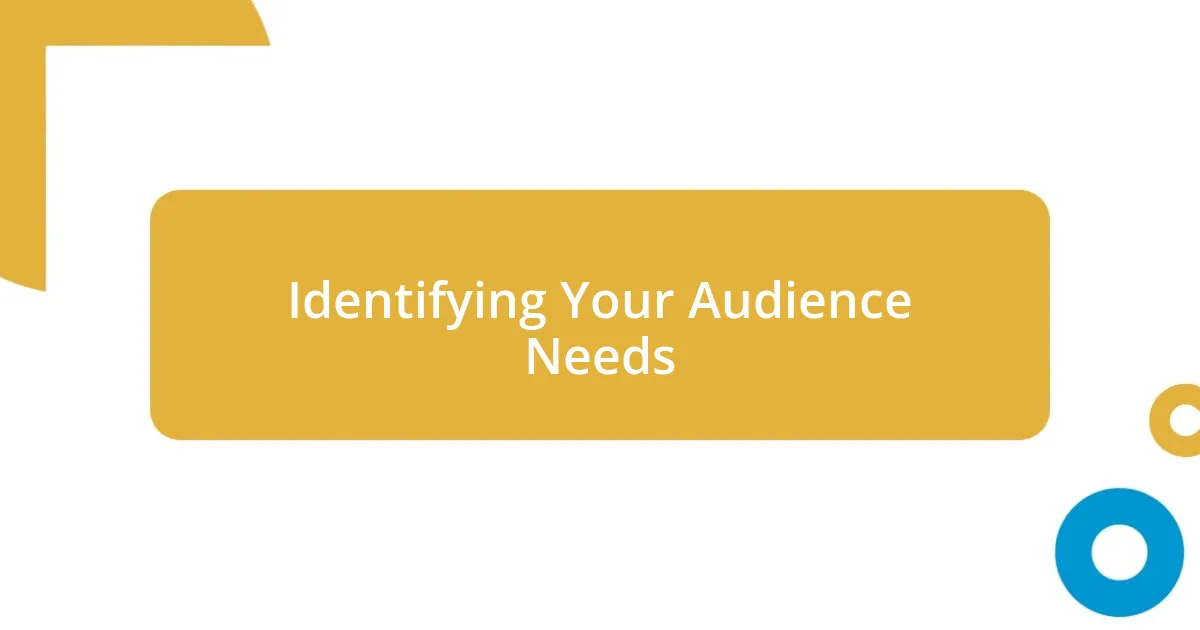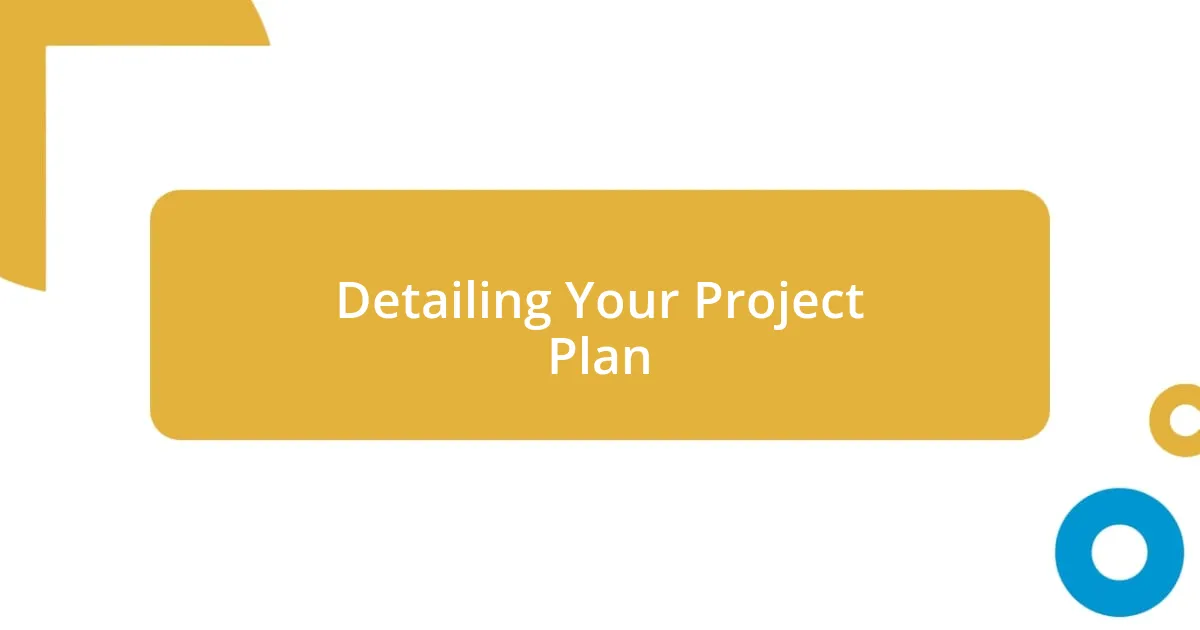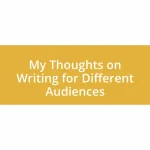Key takeaways:
- Proposal writing requires understanding and addressing the audience’s specific needs for genuine and targeted engagement.
- Defining clear goals enhances the focus of the proposal and helps measure its success.
- Utilizing visuals and specific details in budget and project plans fosters clarity and builds trust with stakeholders.
- Engaging in peer feedback during the editing process significantly improves the proposal’s effectiveness and emotional resonance.

Understanding Proposal Writing
Proposal writing is more than just putting words on paper; it’s about crafting a narrative that resonates with the reader. I remember the first proposal I submitted. I spent weeks tweaking every word, trying to make my passion for the project shine through. I wondered, how can I convey my enthusiasm while also addressing the client’s needs? That’s the essence of proposal writing—showing not just what you can provide but why it matters to the recipient.
Consider the emotions behind a proposal. It’s a bit like asking someone out on a date; you want to create a connection. When I focus on understanding the goals and challenges of the people I’m addressing, I find my proposals become more genuine and targeted. Have you ever felt the difference between a generic offer and one that feels tailored just for you? Crafting a proposal that speaks directly to the client’s unique situation creates that very same sense of importance.
A well-structured proposal also enhances clarity, which is crucial. I’ve been in situations where I received feedback about my proposals being overwhelming due to too much jargon. It made me realize that the real challenge lies in presenting complex ideas simply. How can we break down heavy concepts into digestible pieces without losing the essence? It requires a delicate balance, but with practice, it becomes easier to connect with the audience through simplicity and clarity.

Identifying Your Audience Needs
Identifying your audience’s needs is crucial for crafting a successful proposal. I remember a time when I diligently researched a potential client’s industry, only to discover they were facing a specific challenge that I’d completely overlooked. By tailoring my proposal to address this need, I not only demonstrated my understanding of their situation but also positioned myself as a valuable partner. It’s essential to dig deep into what drives your audience to ensure your proposal resonates.
When I think about audience needs, I often reflect on the importance of empathy. I once wrote a proposal for a non-profit organization struggling to secure funding. Instead of focusing solely on my services, I highlighted the impact their mission could have with my support. Have you ever noticed how proposals that acknowledge the reader’s aspirations tend to feel more engaging? Incorporating their values makes your proposal less of a sales pitch and more of a conversation.
Lastly, specificity is key. Generalities can often dilute your message. For instance, I recall a project where I mistakenly used vague terms to describe deliverables. The feedback was clear: the client wanted precise details to feel confident in my commitment. Establishing clear expectations not only addresses audience needs but also builds trust. Crafting at this level requires attention to detail and a willingness to engage your audience directly.
| Need | Approach |
|---|---|
| Specific Challenges | Research and address directly |
| Values and Aspirations | Highlight how your service aligns |
| Clear Expectations | Use specific language and details |

Defining Your Proposal Goals
Defining the goals of your proposal is a vital step that shapes its direction and focus. I recall working on a proposal that initially lacked a clear goal. I found myself wandering through ideas without really understanding what I wanted to achieve. By taking a moment to define my main objectives—whether it was securing funding, establishing a partnership, or showcasing expertise—I could streamline my messaging and create a more compelling narrative.
- Clarity of Purpose: Identifying what you want from the proposal gives you a clear lens through which to view your content.
- Targeted Messaging: When your goals are set, the message becomes more directed, reducing the risk of diluting your expertise.
- Measurable Outcomes: Establishing specific goals allows you to measure success post-proposal, helping you learn and improve for future opportunities.
Furthermore, setting these goals isn’t just a checklist—it’s a reflective practice. I often spend time envisioning the end result of my proposals. Picture yourself receiving a positive response and how that aligns with your ambitions. This emotional connection drives not just the proposal’s creation but also fuels my passion during the writing process. By connecting your goals with your deeper motivations, you create a proposal that’s not only coherent but also genuine, which helps establish trust with your reader.

Crafting a Compelling Executive Summary
Crafting a compelling executive summary is like painting a picture of your proposal’s essence. I once wrote an executive summary that succinctly highlighted the project’s purpose, anticipated outcomes, and unique value proposition, and the result was striking. It guided the reader’s understanding and set the tone for the detailed content that followed. Think about it—what’s the first impression you want to leave? A concise executive summary can compel stakeholders to read further, while an unfocused one can lead to swift rejection.
When I reflect on my experiences, I often realize how critical it is to connect emotionally with the reader in the executive summary. In a recent proposal for a community initiative, I shared a brief story about an individual whose life was transformed by the project’s goals. This simple anecdote resonated deeply, illustrating not just what we aimed to achieve but also why it mattered. Have you ever noticed how storytelling can amplify your message? It’s a powerful tool that makes your proposal memorable.
Moreover, brevity is crucial in an executive summary. I’ve learned to keep it focused, ideally within a page, ensuring that every word serves a purpose. During one proposal, I included too much detail initially, which diluted my main message. By revisiting it and chopping down unnecessary information, I kept the strength of my proposal clear and compelling. The key is to distill your ideas until only the most impactful points remain; this will not only capture attention but also foster greater understanding.

Detailing Your Project Plan
Detailing your project plan is where the magic truly begins. When I draft a project plan, I always break it down into clear, actionable steps. For instance, during a previous project, setting up timelines and deliverables helped me stay organized and focused. The clarity in this structure not only facilitated my workflow but also made it easier for collaborators to understand what was expected of them. Have you ever found yourself juggling multiple tasks without a clear plan? That’s a recipe for chaos.
One aspect that stands out to me is the importance of visual elements. I remember integrating Gantt charts into a proposal, which vividly illustrated the project timeline. This tool helped both me and my stakeholders visualize the workflow and identify potential bottlenecks before they could arise. I believe that visuals can transform complex ideas into something more graspable—don’t you think they invite better engagement?
Lastly, I can’t stress enough how vital it is to anticipate potential challenges within your project plan. In my own experience, listing out possible obstacles alongside my solutions turned uncertainty into confidence. For example, I once detailed a risk management strategy for a tech initiative that I was proposing. By openly discussing both risks and solutions, I found that it reassured my audience and demonstrated my comprehensive understanding of the project. Doesn’t it make sense that being prepared can significantly enhance your proposal’s strength?

Presenting a Budget and Timeline
Presenting a budget and timeline may seem daunting, but I’ve found that transparency can be incredibly reassuring for stakeholders. During a recent proposal, I laid out a detailed budget that broke down every cost associated with the project—inclusive of materials, labor, and contingencies. This level of detail not only justified the funding request but also built trust, as it showed that I had thoroughly thought through the financial aspects. Do you ever wonder how detailed your budget needs to be? Striking a balance is key; enough detail for clarity, but not so much that it overwhelms.
When it comes to timelines, I rely heavily on realistic projections. In one project, I initially set ambitious deadlines to impress my audience, but I quickly learned the importance of setting achievable goals. Adjusting my timeline to reflect a more cautious approach not only reduced stress for my team but also led to better results overall. Have you experienced the difference between optimism and realism in project timelines? I find that managing expectations can lead to smoother progress and greater satisfaction.
Visual aids can transform how you present a budget and timeline. For example, the last time I created a budget overview, I used pie charts to represent each budget category. This simple shift made the information far more digestible for my audience, who seemed genuinely engaged as they could quickly glean where funds were allocated. It’s fascinating how a well-designed visual can communicate so much—don’t you think that sometimes, images can speak louder than words?

Reviewing and Editing Your Proposal
When it comes to reviewing and editing your proposal, I genuinely believe that stepping away from the document for a little while can work wonders. After completing a draft, I often take a break, allowing my mind to reset. When I return, I’m able to spot inconsistencies and awkward phrases that I might have glossed over initially. Have you ever noticed how a fresh perspective can unveil hidden issues? It’s almost like looking at a piece of art after letting it sit for a day—it suddenly reveals details you didn’t notice before.
The editing phase is where the proposal comes alive. In one instance, I found that a single, powerful sentence had the potential to change the entire tone of my document. By tightening my language and cutting unnecessary words, my message became less cluttered and more direct. Isn’t it fascinating how clarity can enhance your narrative? I often ask myself whether each word serves a purpose, ensuring that my proposal stays focused and impactful.
Ultimately, I believe that peer feedback is an invaluable part of the editing process. Incorporating insights from colleagues not only offers a wider perspective but also helps me refine my ideas. On one occasion, a colleague pointed out that my proposal lacked emotional resonance. Taking her advice to heart, I added a heartfelt story about the community impact of the project, which undeniably transformed the proposal. Does this make you consider how collaboration could reshape your own writing? I’ve learned that a little outside perspective can elevate my proposals to a whole new level.












